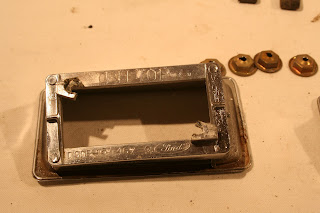1970 1971 Torino and Ranchero Side Marker Lights
It seems like most of the 70-71 mid sized Ford/Mercury cars that I look at are missing at least one (and many times all) of the side marker lights. I suppose they are removed in preparation for paint. They are the proverbial missing sock in the dryer. During every restoration, I have struggled to find the correct sets of parts and side markers are a usual problem.
Here is a little info that may help you in your quest to find that missing sock. The Cyclone (Montego) have a different marker set than the Torino. The Ranchero front markers are the same as the Torino. The Ranchero rear markers are unique to the Ranchero.
The Torino and Ranchero side markers breakdown as follows. There is a left and right metal backing plate. A clean set will have a Ford logo visible and will show RH or LH. The left bezel part number is D0OB- 15A441 and it also shows LH. The right bezel part number is D0OB-15A440-B and it also shows RH. These markers come in pot metal and plastic with the same part number. The front marker amber light assembly fits either side and has part number D0OB-15A428-A.
The Torino rear side markers breakdown as follows. The backing assemblies come in both plastic and metal. I am unable to find a part number on either. There is a left and right backing assembly. At the factory, they had a RH and LH tag. It takes a keen eye tell the difference if the tag is missing. I usually figure it out by trial and error. The right side bezel has part number D0OB-15A4660-C and is marked RH. The left side bezel part number is D0OB-15A467-C and is marked LH. Like the fronts, these come in plastic and metal construction. The red light assembly has the same part number as the front.
I have seen some good quality reproduction marker lights but they do not have the Ford logo. The RH and LH tags for the rear backing plates are also available in reproduction.
I hope this is helpful. Please feel free to add or correct my posting.



















